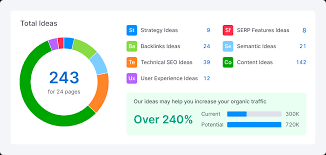SEO Analysis: Unlocking the Power of Data to Boost Your Website’s Performance
In today’s digital age, having a strong online presence is crucial for businesses to thrive. With millions of websites competing for attention, it’s essential to ensure that your website stands out from the crowd. This is where SEO analysis comes into play.
SEO analysis, or search engine optimization analysis, is the process of evaluating your website’s performance and identifying areas for improvement. By examining various elements such as keywords, content quality, backlinks, and technical aspects, you can optimize your website to rank higher in search engine results pages (SERPs) and attract more organic traffic.
One of the key benefits of SEO analysis is that it provides valuable insights into how search engines view your website. It helps you understand what aspects are working well and which ones need attention. Let’s delve deeper into some essential components of SEO analysis:
- Keyword Research: Keywords are the foundation of any successful SEO strategy. Through thorough keyword research, you can identify relevant terms and phrases that your target audience uses when searching for products or services similar to yours. By incorporating these keywords strategically throughout your website’s content, meta tags, and headers, you increase your chances of ranking higher in SERPs.
- On-Page Optimization: On-page optimization involves optimizing various elements within individual web pages to improve their visibility in search results. This includes optimizing meta tags (title tags and meta descriptions), headers (H1-H6 tags), URL structures, image alt text, and internal linking structure. A comprehensive SEO analysis helps identify areas where on-page optimization can be enhanced for better search engine visibility.
- Content Quality: Content is king when it comes to SEO. Search engines prioritize high-quality content that provides value to users. An SEO analysis assesses factors such as content relevance, uniqueness, readability, and engagement metrics like bounce rate and time on page. By understanding how well your content performs, you can make informed decisions about improving existing content or creating new, compelling pieces.
- Backlink Profile: Backlinks are links from other websites that point to your site. They are an essential factor in search engine algorithms as they indicate the credibility and authority of your website. SEO analysis helps evaluate the quality and quantity of backlinks, identifying opportunities for building new links and removing toxic or low-quality ones.
- Technical SEO: Technical aspects of your website, such as site speed, mobile-friendliness, crawlability, and indexability, play a crucial role in search engine rankings. An SEO analysis examines these technical elements to ensure that your website is optimized for both users and search engines.
By conducting a thorough SEO analysis, you gain valuable insights into how well your website performs in search engine rankings and identify opportunities for improvement. Armed with this knowledge, you can develop an effective SEO strategy to boost your website’s visibility and attract more organic traffic.
It’s important to note that SEO analysis is an ongoing process. Search engine algorithms evolve constantly, and competitors are always striving to improve their own rankings. Regularly monitoring and analyzing your website’s performance allows you to stay ahead of the curve and adapt your strategies accordingly.
In conclusion, SEO analysis is a powerful tool that helps unlock the potential of your website by harnessing the power of data. By understanding how search engines view your site and optimizing it accordingly, you can increase its visibility in search results, attract more organic traffic, and ultimately achieve greater online success. Embrace the power of SEO analysis today and take your website’s performance to new heights!
6 Frequently Asked Questions About SEO Analysis: A Comprehensive Guide
- What is SEO analysis?
- How do I analyze my website for SEO?
- What factors should I consider when conducting an SEO analysis?
- How often should I conduct an SEO analysis?
- What are the best tools for conducting an SEO analysis?
- How can I improve my website’s ranking through SEO analysis?
What is SEO analysis?
SEO analysis, also known as search engine optimization analysis, is the process of evaluating and assessing various factors that impact a website’s visibility and performance in search engine rankings. It involves analyzing data and metrics related to keywords, content quality, backlinks, technical aspects, and user experience to identify areas for improvement.
The primary goal of SEO analysis is to understand how well a website aligns with search engine algorithms and user expectations. By examining these factors, website owners and digital marketers can make informed decisions about optimizing their websites to improve organic search rankings and attract more targeted traffic.
SEO analysis typically involves several key components:
- Keyword Research: This involves identifying relevant keywords and phrases that users use when searching for products or services in your industry. Keyword research helps inform content creation and optimization strategies.
- On-Page Optimization: This focuses on optimizing individual web pages by incorporating target keywords into meta tags, headers, URLs, image alt text, and other on-page elements to improve search engine visibility.
- Content Quality Assessment: Evaluating the quality of website content is crucial for SEO success. This includes analyzing factors such as relevance, uniqueness, readability, engagement metrics (bounce rate, time on page), and overall user experience.
- Backlink Profile Analysis: Backlinks from other reputable websites signal trustworthiness and authority to search engines. Analyzing the quality and quantity of backlinks helps identify opportunities for building new links or removing toxic or low-quality ones.
- Technical SEO Evaluation: Technical aspects such as site speed, mobile-friendliness, crawlability (how easily search engines can access your site), indexability (how well your pages are included in search engine indexes), and structured data markup are assessed for optimal performance.
By conducting a comprehensive SEO analysis regularly, website owners can gain insights into their website’s strengths and weaknesses in terms of search engine optimization. These insights allow them to develop effective strategies for improving their website’s visibility, organic search rankings, and overall online presence.
It’s important to note that SEO analysis is an ongoing process as search engine algorithms evolve, industry trends change, and competitor landscapes fluctuate. Regular monitoring and analysis are essential to stay ahead of the competition and adapt strategies accordingly.
In summary, SEO analysis is a systematic evaluation of various factors that impact a website’s performance in search engine rankings. It helps website owners identify areas for improvement and develop effective strategies to optimize their websites for better visibility, increased organic traffic, and improved online success.
How do I analyze my website for SEO?
Analyzing your website for SEO involves examining various aspects to identify areas for improvement. Here are some steps to help you get started with the SEO analysis process:
- Keyword Research: Start by conducting keyword research to identify relevant keywords and phrases that your target audience is searching for. Use tools like Google Keyword Planner, SEMrush, or Moz’s Keyword Explorer to discover popular keywords and their search volumes.
- On-Page Optimization: Evaluate your website’s on-page elements such as meta tags (title tags and meta descriptions), headers (H1-H6 tags), URL structures, and internal linking structure. Ensure that your target keywords are strategically incorporated into these elements.
- Content Quality: Assess the quality of your website’s content. Is it unique, relevant, and engaging? Analyze metrics like bounce rate, time on page, and social shares to determine how well your content is resonating with users.
- Backlink Profile: Examine the quantity and quality of backlinks pointing to your website. Tools like Ahrefs or Majestic can help you analyze your backlink profile, identifying toxic or low-quality links that may be harming your SEO efforts.
- Technical SEO: Evaluate technical aspects such as site speed, mobile-friendliness, crawlability, and indexability. Use tools like Google PageSpeed Insights or GTmetrix to assess your site’s performance and identify areas for improvement.
- User Experience (UX): Analyze the overall user experience of your website. Is it easy to navigate? Are there any usability issues? Consider factors such as site structure, navigation menus, intuitive design, and mobile responsiveness.
- Competitor Analysis: Study the websites of your top competitors in search rankings. Analyze their on-page elements, content strategies, backlink profiles, and user experience to gain insights into what they are doing well.
- Analytics Data: Utilize web analytics tools like Google Analytics to gather data on your website’s performance. Analyze metrics such as organic traffic, conversion rates, and user behavior to understand how well your SEO efforts are driving results.
- Local SEO Analysis (if applicable): If you have a local business, assess your website’s local SEO performance. Optimize your Google My Business listing, analyze local search rankings, and solicit customer reviews.
- Regular Monitoring: Remember that SEO analysis is an ongoing process. Continuously monitor and track changes in rankings, traffic, and other key metrics to stay informed about the impact of your optimization efforts.
By following these steps and utilizing various SEO tools and analytics data, you can conduct a comprehensive analysis of your website’s SEO performance. This analysis will help you identify areas for improvement and develop an effective strategy to enhance your website’s visibility in search engine results pages (SERPs).
What factors should I consider when conducting an SEO analysis?
When conducting an SEO analysis, it’s important to consider several key factors that contribute to your website’s performance and visibility in search engine rankings. Here are some essential factors to consider:
- Keyword Analysis: Evaluate the keywords you are targeting and their relevance to your target audience. Are they aligned with user search intent? Are there any new keyword opportunities you can explore?
- On-Page Optimization: Assess the optimization of individual web pages, including meta tags (title tags, meta descriptions), headers (H1-H6 tags), URL structure, image alt text, and internal linking. Ensure that these elements are optimized for both users and search engines.
- Content Quality: Analyze the quality and relevance of your website’s content. Is it unique, engaging, and valuable to your target audience? Consider factors like readability, keyword usage, multimedia elements, and user engagement metrics (bounce rate, time on page).
- Backlink Profile: Evaluate the quality and quantity of backlinks pointing to your website. Look for opportunities to build high-quality backlinks from authoritative sources while identifying any toxic or low-quality links that may be harming your site’s reputation.
- Technical SEO: Examine technical aspects such as site speed, mobile-friendliness, crawlability, and indexability. Ensure that your website is optimized for optimal user experience and search engine visibility.
- Competitor Analysis: Study the SEO strategies employed by your competitors. Identify their strengths and weaknesses to gain insights into potential areas for improvement in your own strategy.
- User Experience (UX): Consider how well your website caters to user experience. Is it easy to navigate? Does it load quickly? Is it mobile-responsive? A positive user experience contributes to better search engine rankings.
- Analytics Data: Utilize data from tools like Google Analytics or other analytics platforms to understand how users interact with your website. Analyze metrics such as organic traffic, bounce rate, average session duration, and conversion rates to gain insights into user behavior.
- Local SEO (if applicable): If you have a local business, consider factors like local keyword targeting, Google My Business optimization, online reviews, and local directory listings.
- Social Media Presence: Assess your social media presence and its impact on your website’s visibility. Evaluate engagement metrics, follower growth, and the effectiveness of social media campaigns.
Remember that SEO analysis is an ongoing process. Regularly monitor your website’s performance and adapt your strategies based on changing search engine algorithms and industry trends. By considering these factors during your SEO analysis, you can make informed decisions to optimize your website for better search engine rankings and overall online success.
How often should I conduct an SEO analysis?
Conducting regular SEO analysis is essential to stay on top of your website’s performance and adapt to the ever-changing landscape of search engine algorithms. The frequency of conducting an SEO analysis can vary depending on factors such as the size and complexity of your website, the level of competition in your industry, and the resources available to you. However, as a general guideline, it is recommended to conduct an SEO analysis at least once every three to six months.
Here are a few reasons why regular SEO analysis is important:
- Algorithm Updates: Search engines like Google frequently update their algorithms to provide users with the most relevant and high-quality search results. These updates can impact how your website ranks in search engine results. By conducting regular SEO analysis, you can identify any changes in rankings or traffic patterns and make necessary adjustments to align with the latest algorithm updates.
- Competitor Analysis: Keeping an eye on your competitors’ strategies is crucial for staying ahead in the online marketplace. Regularly analyzing their websites allows you to identify opportunities or areas where you can improve your own site’s performance. By benchmarking against competitors, you can gain insights into their tactics and adjust your SEO strategy accordingly.
- Content Optimization: Content plays a significant role in SEO success. Regularly analyzing your content’s performance helps you understand what types of content resonate with your audience and drive organic traffic. By identifying high-performing content, you can optimize it further or create similar content that appeals to both users and search engines.
- Technical Maintenance: Technical aspects of your website, such as site speed, mobile-friendliness, and crawlability, are critical for search engine visibility. Conducting regular SEO analysis allows you to identify any technical issues that may affect your website’s performance or user experience. Fixing these issues promptly ensures that search engines can effectively crawl and index your site.
- Link Building Opportunities: Backlinks are vital for establishing credibility and authority in the eyes of search engines. Regular SEO analysis helps you assess your backlink profile, identify new link building opportunities, and address any toxic or low-quality links that may harm your website’s rankings.
Remember that SEO analysis is an ongoing process, and the frequency may vary depending on your specific circumstances. It’s important to allocate time and resources to conduct regular analyses to ensure that your website remains optimized for search engines and delivers a positive user experience. By staying proactive and adapting to changes, you can maintain a competitive edge in the digital landscape.
What are the best tools for conducting an SEO analysis?
When it comes to conducting an SEO analysis, there are several tools available that can help you gather data and insights to optimize your website. Here are some of the best tools widely used by SEO professionals:
- Google Analytics: This free tool from Google provides valuable insights into your website’s performance, including traffic sources, user behavior, conversions, and more. It helps you understand how users interact with your site and identify areas for improvement.
- Google Search Console: Another free tool from Google, Search Console allows you to monitor your website’s presence in search results. It provides data on keywords that drive organic traffic to your site, crawl errors, backlinks, and more. It also offers valuable information about how Google views and indexes your site.
- SEMrush: SEMrush is a comprehensive SEO tool that offers a wide range of features for keyword research, competitor analysis, backlink analysis, rank tracking, content optimization suggestions, and more. It provides detailed reports and actionable insights to improve your website’s performance.
- Moz Pro: Moz Pro is a popular SEO software suite that offers various tools for keyword research, site audits, rank tracking, link building analysis, and more. It provides in-depth reports and recommendations to help you boost your website’s visibility in search engine rankings.
- Ahrefs: Ahrefs is a powerful SEO toolset known for its extensive backlink database. It offers features like site audits, keyword research, competitor analysis, rank tracking, content explorer for topic research, and more. Ahrefs provides comprehensive insights into backlinks and helps identify opportunities for link building.
- Screaming Frog SEO Spider: This desktop-based tool crawls websites to analyze technical aspects such as broken links, duplicate content issues, meta tag optimization opportunities, page speed analysis, XML sitemap generation/validation, and more.
- Yoast SEO: If you’re using WordPress as your CMS (Content Management System), Yoast SEO is a popular plugin that helps optimize your website’s on-page elements. It provides recommendations for keyword optimization, content readability, meta tags, XML sitemaps, and more.
These are just a few examples of the many SEO analysis tools available. The choice of tools depends on your specific needs and budget. It’s often beneficial to use a combination of tools to gather comprehensive data and insights for effective SEO analysis.
How can I improve my website’s ranking through SEO analysis?
Improving your website’s ranking through SEO analysis involves identifying areas for improvement and implementing effective strategies. Here are some steps you can take:
- Keyword Optimization: Conduct thorough keyword research to identify relevant keywords and phrases that your target audience is searching for. Incorporate these keywords strategically throughout your website’s content, meta tags, headers, and URLs.
- On-Page Optimization: Optimize individual web pages by ensuring proper meta tags (title tags and meta descriptions), headers (H1-H6 tags), URL structures, image alt text, and internal linking structure. Make sure your content is well-structured, readable, and provides value to users.
- High-Quality Content: Create compelling, informative, and unique content that resonates with your target audience. Focus on providing value, answering their questions, and addressing their needs. Regularly update and optimize existing content to keep it fresh.
- Backlink Analysis: Evaluate your backlink profile to identify high-quality links from reputable websites. Build relationships with other relevant websites in your industry for potential link-building opportunities. Remove toxic or low-quality backlinks that may harm your website’s reputation.
- Technical SEO Audit: Conduct a technical SEO analysis to ensure that your website is optimized for search engines’ crawling and indexing processes. Check factors such as site speed, mobile-friendliness, URL structure, XML sitemaps, robots.txt file, and canonical URLs.
- User Experience Optimization: Improve the overall user experience by optimizing site navigation, reducing page load times, enhancing mobile responsiveness, and ensuring easy access to valuable information.
- Monitor Analytics: Regularly monitor website analytics to track important metrics such as organic traffic growth, bounce rate, time on page, conversions, and keyword rankings. Analyze this data to gain insights into user behavior and make data-driven decisions for further optimization.
- Stay Updated: Keep up with the latest SEO trends and algorithm updates to adapt your strategies accordingly. Search engine algorithms evolve, and staying informed will help you maintain and improve your website’s ranking.
Remember, SEO analysis is an ongoing process. Continuously monitor your website’s performance, make necessary adjustments, and regularly analyze the results to ensure long-term success in improving your website’s ranking.




